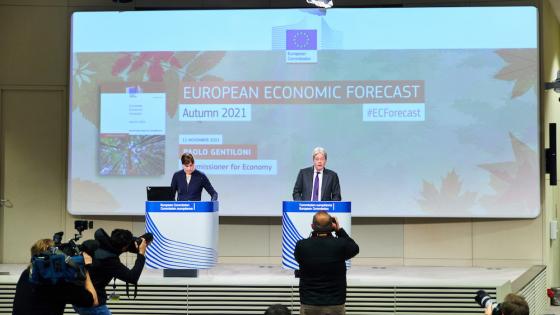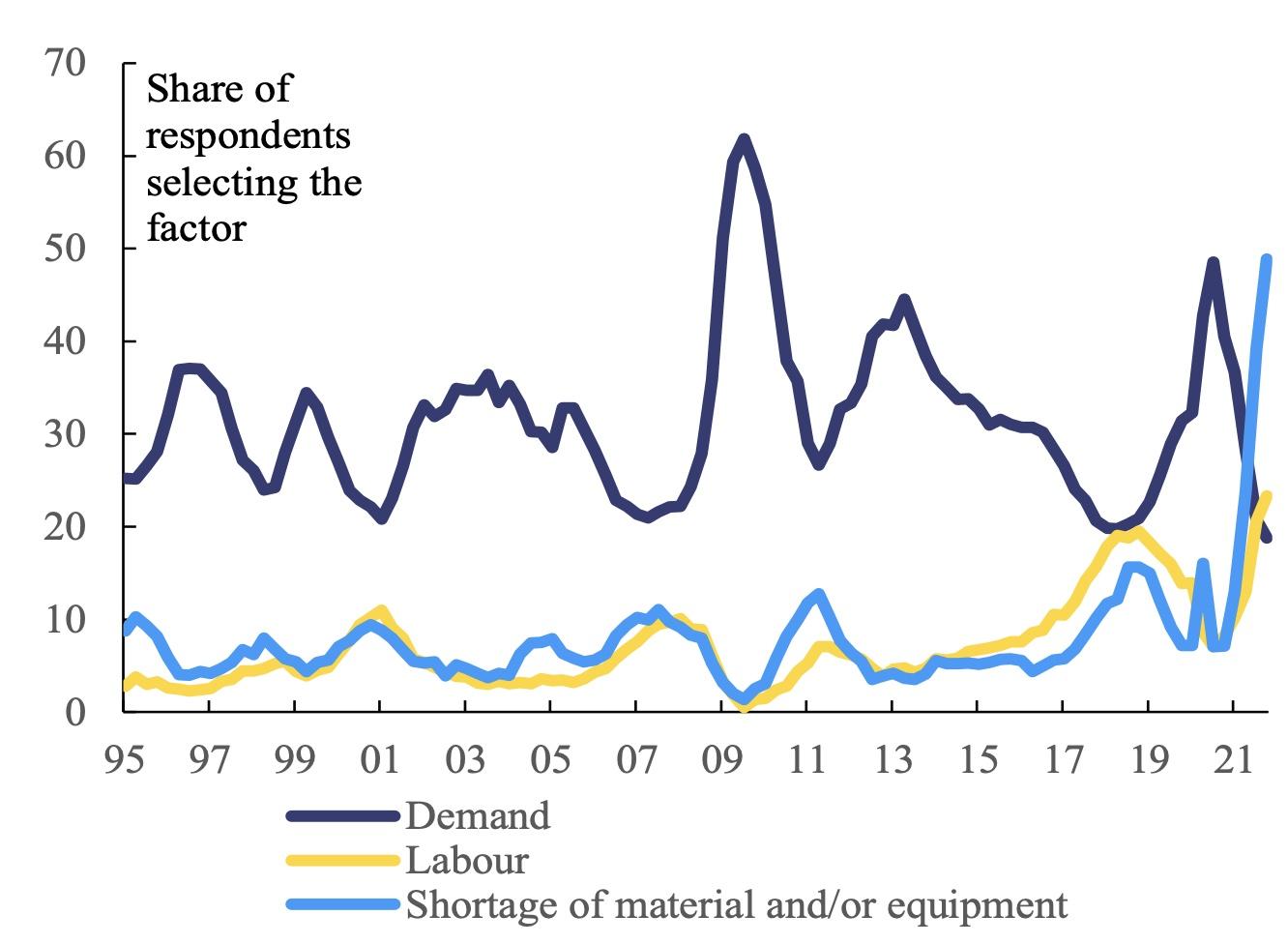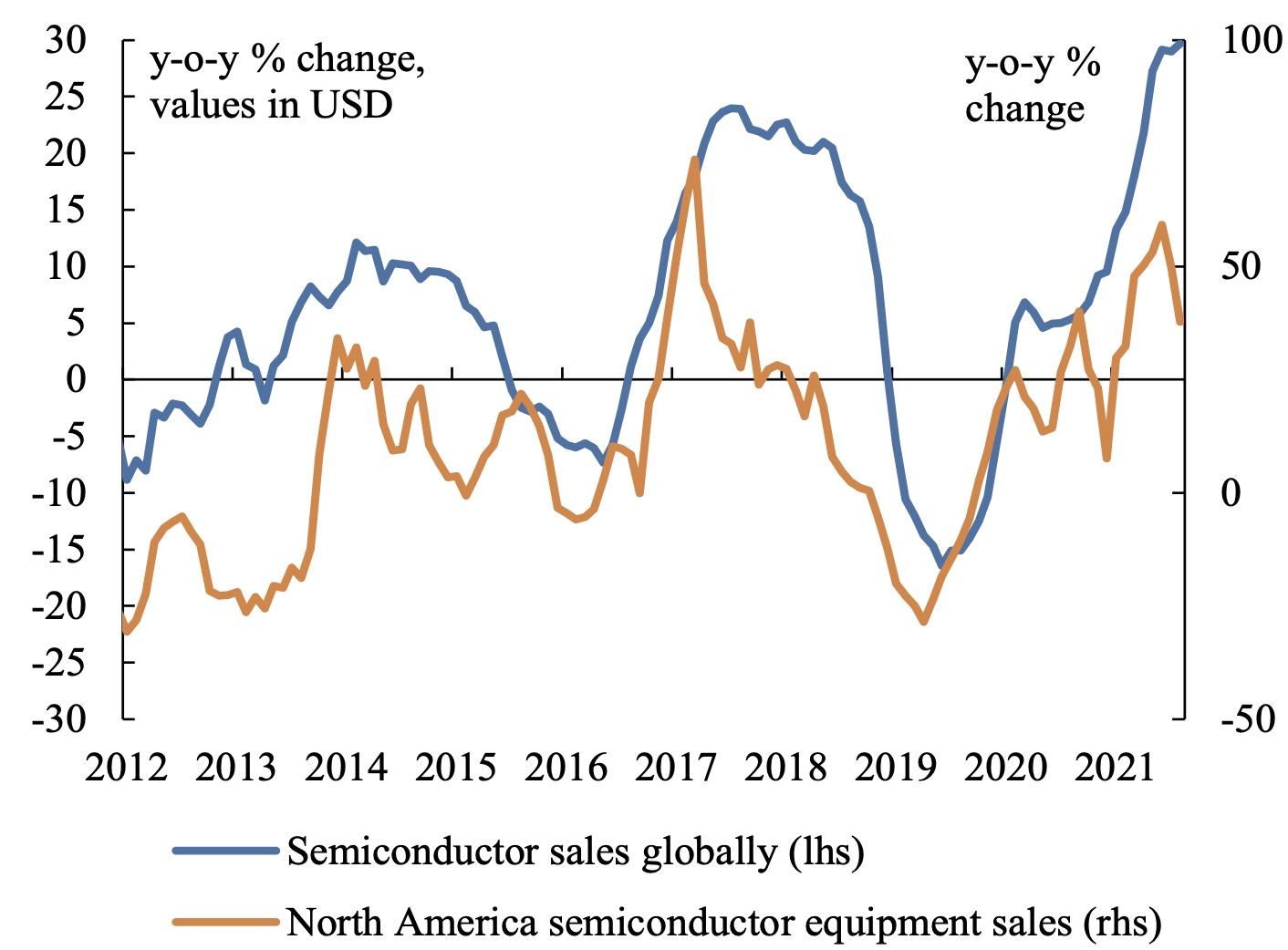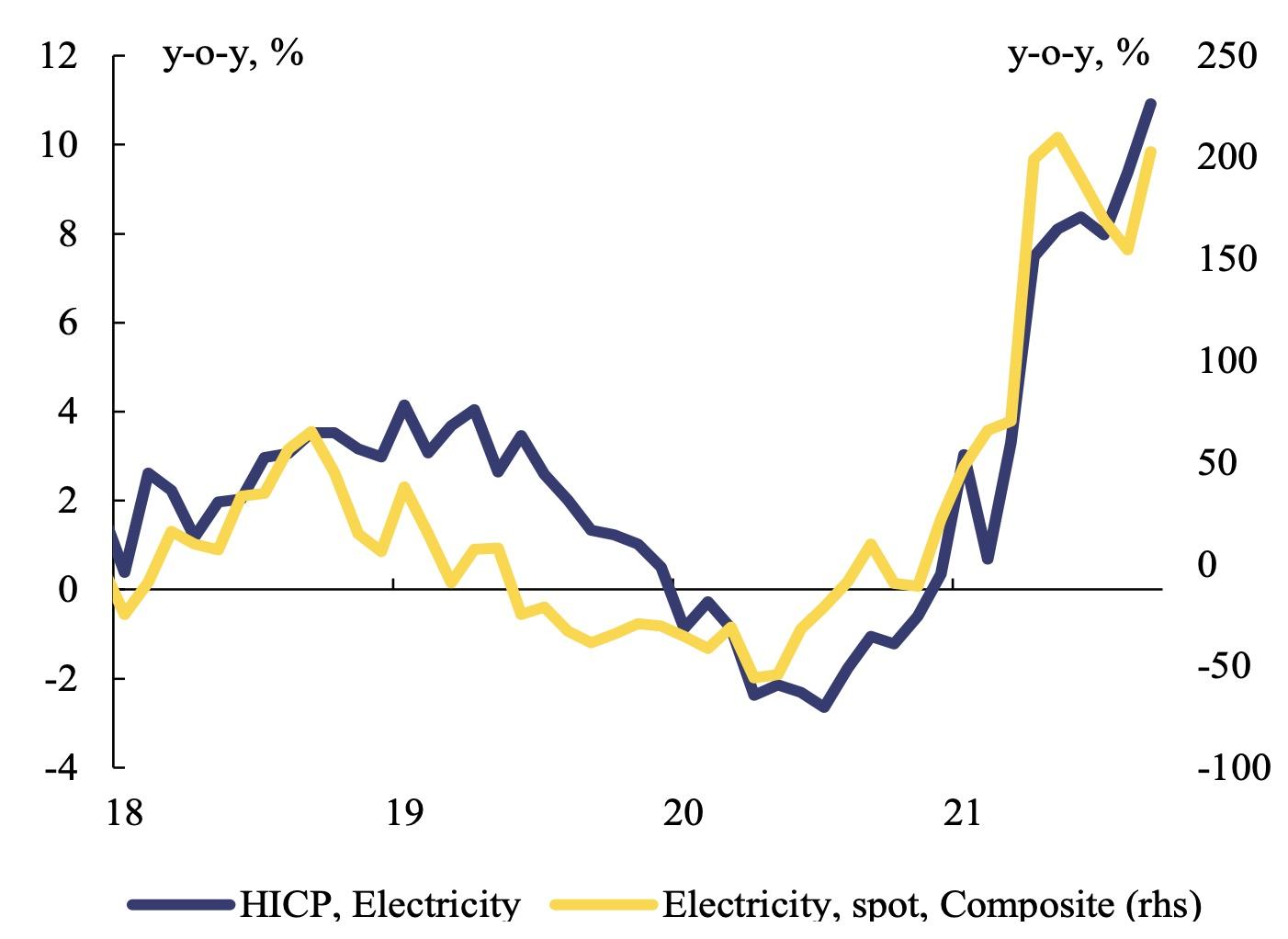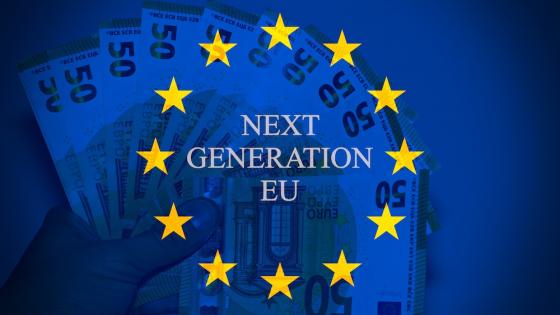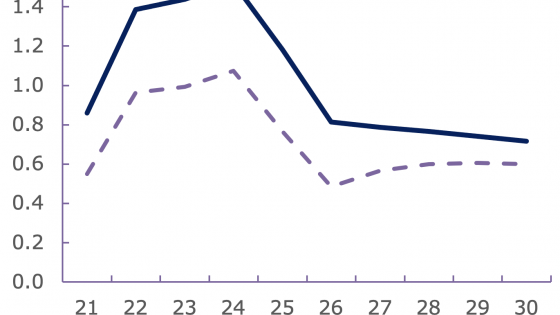The growth outlook for the EU is for a continued economic expansion. With large shares of the population currently protected against severe COVID-19 cases and deaths (ECDC 2021), the EU economy is assumed to avoid lockdowns and to continue benefitting from the reopening momentum. As a result, the EU and the euro area, which were in the third quarter just a notch below their pre-pandemic output levels, are set to transition from recovery to expansion (Figure 1). This projection implies reaching the Commission’s extrapolated pre-pandemic forecast path within the forecast years, and approaching the pre-crisis growth trend much faster than after previous recessions. After the Global Financial Crisis in 2008-09, for example, it took the EU economy more than four years for just returning to the pre-crisis level of output. The atypical nature of the recession and the substantial policy support, including NGEU/RRF, were essential for this result.
Figure 1 EU GDP: Autumn 2021 Forecast and the pre-pandemic trend and forecast
The main growth drivers are set to be on the domestic side. An improving labour market and lower uncertainty should support consumer confidence. Some decumulation of savings accumulated during the lockdown periods, combined with lower saving rates ahead, are set to strengthen consumer spending. Investment should benefit from strong demand growth, favourable financing conditions, and the NextGenerationEU (NGEU)/Recovery and Resilience Facility (RRF) (Canova and Pappa 2021, European Commission 2021a, Mahieu et al. 2021). Due to strong growth in the reopening phase, GDP growth in the EU and the euro area is expected to jump to 5.1% in 2021, reach 4.3% in 2022, and moderate in 2023 to 2.5% in the EU and 2.4% in the euro area (European Commission 2021b).
The inflation outlook for the EU is for a strong rise in 2021 and moderating annual rates in the next two years. Currently, bottlenecks combined with strong base effects and demand pressures are pushing prices up. Still, the narrative that these upward price pressures are strong but only transitory remains intact. This analysis is broadly shared in the latest projections by the IMF (2021), ECB (2021), and OECD (2021). ‘Transitory’ does not, however, necessarily mean ‘short-lived’, and in the light of recent information about the likely persistence of some supply-side disruptions and the usually lagged impact of energy price increases, the rise in inflation is expected to be a bit stronger this year than previously thought, with the moderation taking somewhat longer. Next year, most of the one-off factors (e.g. changes in indirect taxes), commodity price increases, and effects attributable to the reopening of the economy should fall out of the year-on-year calculations. HICP inflation in the EU and the euro area is expected to peak at almost 4% in the fourth quarter, remaining close to 3% in the first quarter of next year, before falling towards 1½% at the end of next year and staying there until the end of 2023.
Uncertainty and risks surrounding the outlook remain very high. The outlook remains dependent on the pandemic, both within and outside of the EU. Important risks also relate to supply and demand mismatches that might prevail longer than currently expected, constraining economic activity and raising price pressures, most notable if emerging wage pressures are passed on to consumer prices.
Table 1 Key figures from the Autumn 2021 Forecast
The following parts of this column zoom in on three issues that are analysed in more depth in the Autumn Forecast: vaccinations; supply constraints, and energy prices. The forecast document provides more details and comprises in addition analyses of the housing market and the state of the labour market recovery.
Vaccines turned the page, but the pandemic remains a threat
The COVID-19 pandemic remains a global health threat. In the EU, the vaccination campaigns are delivering tangible results and have significantly limited the impact of the delta variant. Until November, the number of detected infections surged, but there were fewer severe cases and deaths than in 2020 (Figure 2). The health situation has improved most in member states with high vaccination rates, and the relatively low vaccination rates in some member states remain a source of concern.
Figure 2 New COVID-19 cases and deaths in the EU
Overall, however, the increasing vaccination rates and the adaptation to living with restrictions have lowered the impact of the pandemic on economic activity, as previously expected (European Commission 2021, see also Deb et al. 2021). The assumption underlying the Autumn Forecast is thus that the pandemic will not cause any major economic disruptions in the EU throughout the forecast years.
Demand and supply mismatches constrain production and push prices
During the reopening phase, in several sectors and countries, demand – augmented by unprecedented stimulus – has been outstripping a temporarily disrupted supply. Such consequences of the COVID-19 pandemic are also beginning to show in the EU, where the surge in demand is not being met by sufficient supply in several sectors, especially in the production of durable and investment goods. According to the EU Business and Consumer Surveys, shortages of materials and/or equipment rapidly grew in importance in the course of 2021, replacing demand shortfall as the most important factor limiting production in industry (Figure 3) and coming second in construction (behind labour shortage).
Figure 3 Factors limiting production in the EU industry (BCS survey)
As during the pandemic demand shifted from services towards goods, demand for maritime freight shipments increased in a situation where spare capacity had already been low at the onset of the pandemic. Raw materials are in shortage, reflecting global logistics constraints, cost increases, and lockdowns in major resource countries. Reports from construction companies indicate that dwindling supplies of key building materials are weighing on construction activity.
At the same time, the accelerated digitalisation induced by the pandemic triggered an unprecedented surge in demand for computers and electronic products. Already before the pandemic, semiconductor producers were working at almost full capacity and, due to the long and complex process needed to expand production capacity, the supply of semiconductors is less elastic than needed to meet surging demand. A global semiconductor shortage is adversely affecting a large variety of industries, from carmakers to consumer electronics.
Figure 4 Global semiconductor market
It remains uncertain how quickly these bottlenecks will be resolved, and the time needed for supply to adjust to demand is expected to vary across sectors. Moderation of demand and its rebalancing between goods and services in advanced economies can be expected to provide some relief, but capacity constraints can hold back the response of supply to demand.
Quantifying the impact of mismatches is a challenge (e.g. Attinasi et al. 2021: Box 6). In the Autumn Forecast, an analysis was conducted using Eurostat’s FIGARO input-output database for 2019 and the results were taken into account in the forecast process. Simulations suggest that mismatches result in a significant decline in EU value added, with a highly differentiated impact across member states. Importantly, cross-border spillover effects explain broadly one-fifth of the value-added loss, highlighting the importance of intra-EU linkages in magnifying the shock.
Headwinds from increased energy prices
In assessments of the nature of current inflationary pressures, recent increases in energy prices play a key role. The surge in gas prices reflects strong demand as economies reopened, reduced stocks after a cold winter, scarcity of power (or heating) alternatives, and to a lesser extent the impact of rising carbon emission prices. High gas prices have ripple effects on electricity markets, pushing prices of electricity up. Futures markets signal high gas and electricity prices up to spring 2022, which suggests a rise in retail energy prices for producers and consumers in the near term. However, the pass-through will take time and be partial, with differences across member states depending on the regulation and structure of retail prices, the energy mix, and policy interventions.
Figure 5 Electricity wholesale and retail prices in the euro area
The effects of the increase in energy commodity prices in the euro area are analysed using the European Commission's Global Multi-country model. The magnitude of the shock is derived from assumed import prices of energy commodities as compared to those in spring. On the domestic side, sluggish price adjustment implies only limited short-term pass-through of higher production costs to retail prices. Rising production costs will partly be passed on to consumers via prices, and partly lead to a temporary reduction in the producers’ profit margins. Rising production costs in sectors that use commodities as intermediate inputs raise price pressures and imply that higher commodity prices do not only increase headline but also core inflation. The analysis suggest that rising energy prices could raise headline inflation in the euro area by 0.9 percentage points in 2021 and 1 percentage point in 2021 as compared to spring. Overall, the simulated shock reduces real GDP growth in 2021 by 0.3 percentage points and in 2022 by 0.5 percentage points.
Outlook shapes views on policies
Every new forecast shapes views on the appropriate policy approach. While such considerations go beyond the scope of a forecast, the Autumn Forecast sheds light on a number of issues, which add to previously identified policy areas such as the review of fiscal rules.
- NGEU/RRF. Despite the recovery, the switching-off of economic activity in many parts of the EU for a long period can have lasting consequences, and expectations of a smooth resumption of activity may not be met everywhere. However, the transition out of temporary COVID-19 support measures is not the end of policy support, and measures such as the EU's Next Generation EU, with the Recovery and Resilience Facility at its centre, have more ambitious aims than just returning to the situation at the onset of the pandemic.
- Addressing heterogeneity. The recovery is uneven across countries, though less so than expected (Verwey and Döhring 2020). The new forecast points to some successful efforts of keeping cross-country differences limited, but also hints at vaccination rates and the exposure to supply-side constraints as causes of differences across member states.
- Coping with climate challenges. The recent rise in inflation has given more prominence to scenarios under which inflation remains high for longer. Climate change and mitigation policies are set to affect relative prices and therefore matter for inflation both in the short and in the longer term. Globalisation and cross-border fragmentation of production, which had a negative impact on trend inflation (Balatti et al. 2021), may be decelerating or even reversing.
These aspects of the Autumn 2021 Forecast hint at the need of putting emphasis on long-term developments also in business cycle forecasts, overcoming a short-term bias that not only forecasts but also policy choices would suffer from.
References
Attinasi, M G et al. (2021), “The semiconductor shortage and its implication for euro area trade, production and prices”, ECB Economic Bulletin 4, June: 78-82
Balatti, M et al. (2021), “Globalisation and inflation: Insights from the ECB strategy review”, VoxEU.org, 11 October.
Canova, F and E Pappa (2021), “On the effectiveness of the Next Generation EU funds”, VoxEU.org, 9 November.
Deb, P. et al. (2021), “The effects of COVID-19 vaccines on economic activity”, IMF Working Paper WP/21/248, October.
ECB (2021), ECB staff macroeconomic projections for the euro area, September.
ECDC – European Centre for Disease Prevention and Control (2021), “Rapid Risk Assessment: Assessing SARS-CoV-2 circulation, variants of concern, non-pharmaceutical interventions and vaccine rollout in the EU/EEA, 16th update”, 30 September.
European Commission (2021a), “European Economic Forecast – Spring 2021”, European Economy Institutional Paper 149, May.
European Commission (2021b), “European Economic Forecast – Autumn 2021”, European Economy Institutional Paper, November.
IMF (2021), World Economic Outlook, October.
Mahieu, G, P Pfeiffer, J Varga and J in ‘t Veld (2021), “A stylised quantitative assessment of Next Generation EU investment”, VoxEU.org, 4 August.
OECD (2021), OECD Economic Outlook, Interim Report September: Keeping the Recovery on Track, OECD Publishing.
Verwey, M and B Döhring (2020), “Deeper recession, wider divergences: The Commission’s Summer 2020 interim forecast”, VoxEU.org, 7 July.
